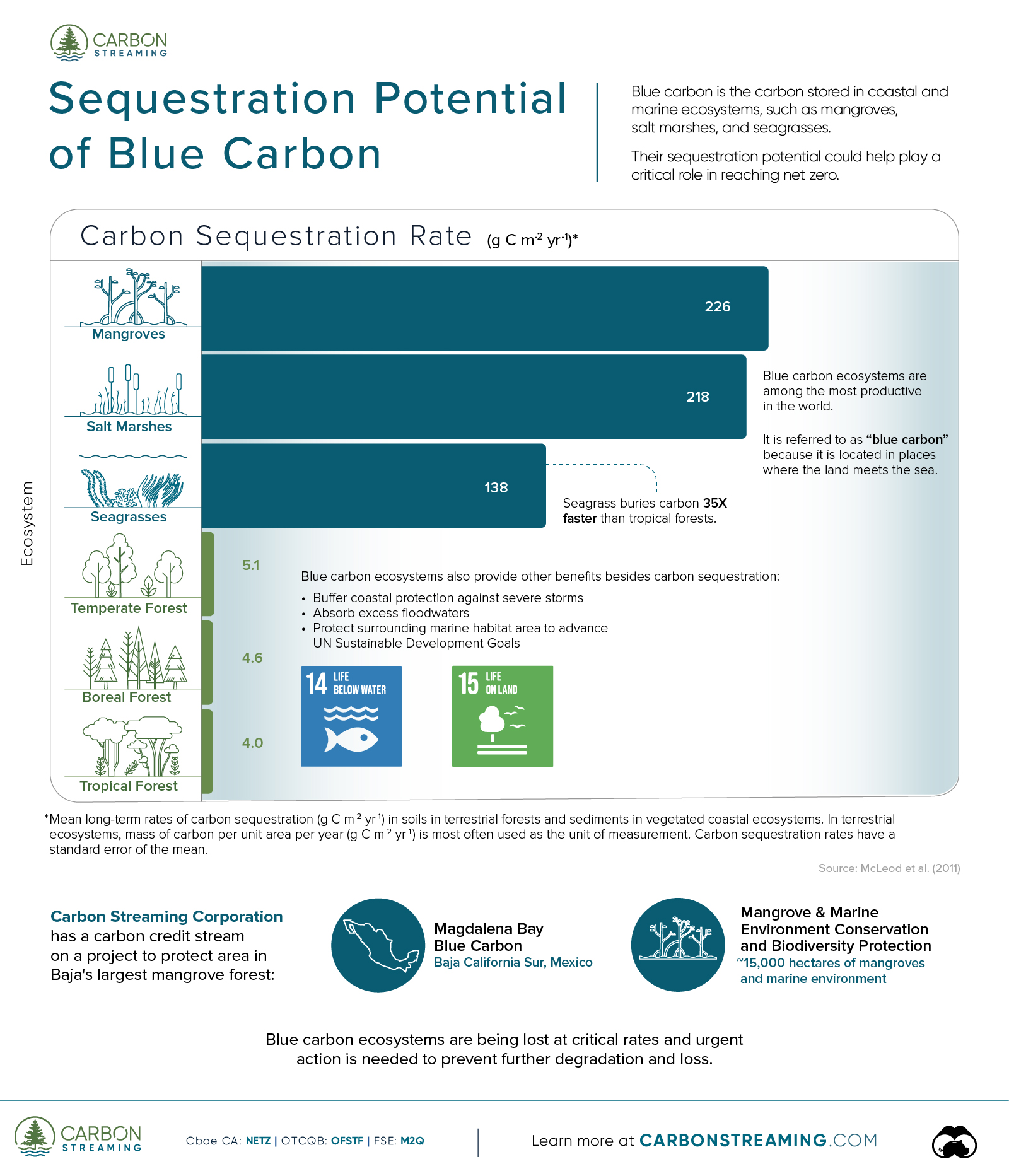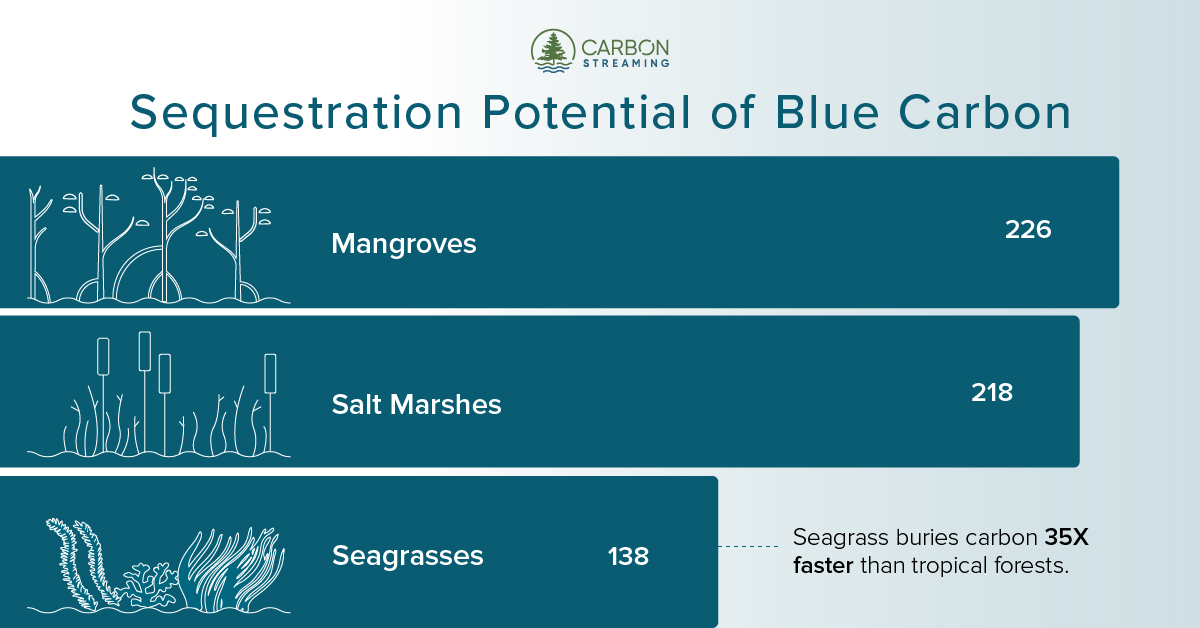How Blue Carbon Combats Climate Change

How Blue Carbon Combats Climate Change
Today, 33 billion metric tons of carbon is stored in blue carbon ecosystems.
For context, this is equal to 81% of the emissions produced globally in 2023. These blue carbon sinks play an important role in locking away carbon and are found across three main ecosystems:
- Mangroves
- Salt marshes
- Seagrasses
This graphic, sponsored by Carbon Streaming Corporation, illustrates the significant sequestration potential of blue carbon.
Carbon Sequestration Potential by Ecosystem
Blue carbon ecosystems are among the most productive in the world—meaning their plants usually grow a lot each year, and in the process, sequester large amounts of carbon.
In addition, their soils are largely anaerobic (without oxygen) so carbon that gets incorporated into the soils decomposes very slowly and can remain intact and stored for hundreds or even thousands of years.
In fact, mangroves sequester carbon 56 times faster than tropical forests.
| Ecosystem | Carbon Sequestration Rate (g C m-2 yr-1)* |
|---|---|
| Mangroves | 226 |
| Salt Marshes | 218 |
| Seagrasses | 138 |
| Temperate Forest | 5.1 |
| Boreal Forest | 4.6 |
| Tropical Forest | 4.0 |
*Mean long-term rates of carbon sequestration (g C m-2 yr-1) in soils in terrestrial forests and sediments in vegetated coastal ecosystems. In terrestrial ecosystems, mass of carbon per unit area per year (g C m-2 yr-1) is most often used as the unit of measurement. Carbon sequestration rates have a standard error of the mean. Source: McLeod et al. (2011)
Salt marshes, found largely along the coastlines of North America and Australia, are another highly efficient carbon sink.
As a complex ecosystem, they protect shorelines from flooding and help prevent property damage in nearby communities. Yet between 2000 and 2019, the world lost 561 square miles of salt marshes, equal to around twice the size of Singapore.
One study showed that one hectare of seagrass absorbs the equivalent carbon dioxide as 15 hectares of rainforest each year. This is in part due to the fact that they trap organic matter and sediments that contain carbon.
Meadows of seagrasses, known as the ocean’s ‘lungs’, are found across every continent globally with the exception of Antarctica.
Blue Carbon Rate of Loss
In the last 40 years, 20% of the world’s mangroves have been destroyed due to shrimp farming, palm oil plantations, and other commercial activities. Natural retraction has also played a role.
By some estimates, the world’s unprotected mangroves could be eliminated in the next 100 years.
Disappearing salt marshes are just as concerning. One study showed that their global loss was equal to the size of two soccer fields each hour over the 20 years from 2000 to 2019. This resulted in the release of annual estimated net global emissions equivalent to the annual emissions of 3.5 million cars.
Protecting Vital Ecosystems with Carbon Credits
Blue carbon ecosystems are being lost at critical rates and urgent action is needed to prevent further degradation and loss.
Projects funded by carbon credits ensure that these ecosystems are protected. Through the sale of carbon credits, it is more economically viable for preserving mangroves and salt marshes than using them for other commercial activities.
One example is the Magdalena Bay Blue Carbon Project in Mexico, which protects roughly 15,000 hectares of mangroves and marine environment from shrimp farming seen in nearby areas. The project aims to advance nine UN Sustainable Development Goals (UN SDGs) in its work to protect biodiversity and promote new economic opportunities in local communities.
Over 30 years, the project, which Carbon Streaming has a carbon credit stream agreement, is expected to reduce greenhouse gas emissions of an estimated 25 million tonnes of carbon dioxide equivalent.
The Benefits of Blue Carbon Ecosystems
Blue carbon ecosystems provide other advantages beyond carbon sequestration, such as:
- Buffer coastal protection against severe storms
- Absorb excess floodwaters
- Protect surrounding marine habitat area to advance UN SDGs
By conserving these critical ecosystems, carbon credits play an important role in overcoming climate challenges to help the world reach net zero.

Learn more about Carbon Streaming.

-

 Green4 hours ago
Green4 hours agoThe Carbon Footprint of Major Travel Methods
Going on a cruise ship and flying domestically are the most carbon-intensive travel methods.
-

 Green2 weeks ago
Green2 weeks agoRanking the Top 15 Countries by Carbon Tax Revenue
This graphic highlights France and Canada as the global leaders when it comes to generating carbon tax revenue.
-

 Green2 weeks ago
Green2 weeks agoRanked: The Countries With the Most Air Pollution in 2023
South Asian nations are the global hotspot for pollution. In this graphic, we rank the world’s most polluted countries according to IQAir.
-

 Green2 weeks ago
Green2 weeks agoTop Countries By Forest Growth Since 2001
One country is taking reforestation very seriously, registering more than 400,000 square km of forest growth in two decades.
-

 Green3 weeks ago
Green3 weeks agoRanked: Top Countries by Total Forest Loss Since 2001
The country with the most forest loss since 2001 lost as much forest cover as the next four countries combined.
-

 Agriculture2 months ago
Agriculture2 months agoThe World’s Top Cocoa Producing Countries
Here are the largest cocoa producing countries globally—from Côte d’Ivoire to Brazil—as cocoa prices hit record highs.


